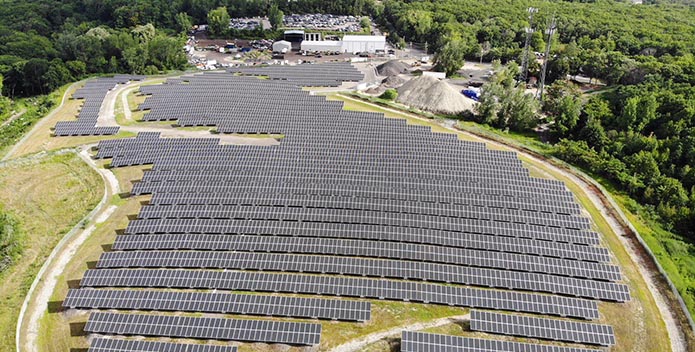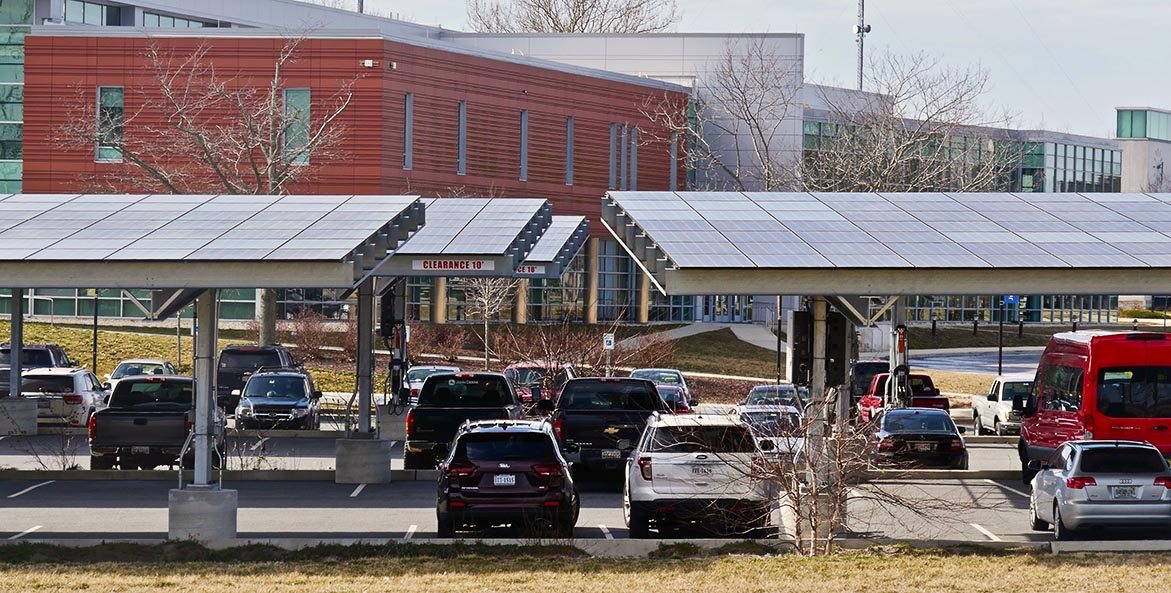The environmental benefits of solar facilities, however, depend greatly on how they are designed, located, and developed. Clearing forests, wetlands, or prime farmland for solar farms can degrade wildlife habitat and diminish the land’s ability to naturally filter and clean water, leading to more pollution in rivers and streams. On the other hand, solar facilities that make use of degraded or developed land can both protect waterways and achieve clean energy goals.
CBF advocates for solar development that follows these seven best practices to safeguard water quality and promote community well-being in the Chesapeake Bay watershed.
- Encourage solar facilities in locations that take advantage of previously developed land, minimizing further disturbance to the landscape.
- Residential Rooftops. Encouraging solar panels on the rooftops of homes is one way to reduce the impact of widespread power interruptions and help meet those properties’ energy needs. Some states limit how much power can be supplied by rooftop solar, or how much of the power generated by rooftop solar panels can be sold back to the grid (a practice known as net-metering). These limits should be enlarged, while recognizing the need to avoid stress on the distribution grid and significant increases in electric rates charged by power utilities.
- Developed Land. Large commercial and industrial sites, such as warehouses and malls, as well as other commercial enterprises, often have large, flat rooftops and parking lots that can be good places for solar panels. Panels on these sites can have the added benefit of providing shade. Public institutions, such as airports, prisons, hospitals, and schools can also provide space for solar, as long as public safety is not compromised.
- Brownfields and Degraded Lands. Lands previously degraded by hazardous pollution, known as brownfields, as well as large landfills and other disturbed areas, can be used to site solar arrays using existing technology that reduces the risk of further disturbing contaminated soil. While the cost to develop these projects may be slightly higher than in other locations, the difference in price for electric customers would likely be small.
- Marginal Farmland. Farmland with low quality soils, or that is fallow (unused), is also a potential site for solar. However, it is important to ensure the design of such arrays allow for water to infiltrate the soil and use low-reflectance, non-polarizing white grids to reduce impacts on insects and waterfowl. Agricultural activities such as beekeeping, the cultivation of shade-loving crops, and even animal husbandry are potentially compatible with somewhat elevated solar arrays in these locations.
- Water Areas Where Shade is Preferred. Large solar arrays might suitably be deployed on certain water bodies such as reservoirs where some shade is environmentally beneficial. Such systems currently exist in places like land-based fish farms.

Siting solar arrays on old landfills, like this solar field in North Providence, Rhode Island, is one best practice for increasing solar capacity without degrading habitat or diminishing the land's natural ability to filter and clean stormwater.
Captona
- Avoid inappropriate locations for solar development that harm environmentally or culturally significant or sensitive areas, including:
- Areas of undeveloped forest and good farmland.
- Federal, state, or local cultural or historic sites, designated scenic areas, or sites with significant adverse impacts to environmental justice communities.
- Wetlands, including resource protection areas identified by Maryland’s Chesapeake Bay Critical Area and Virginia’s Chesapeake Bay Preservation Area laws.
- Watersheds with identified “high quality” streams;
- Watersheds with Total Maximum Daily Load pollution limits set under the Clean Water Act that have little or no capacity to accept new stormwater pollution;
- Areas next to waterways that do not have adequate buffers of plants and trees.
- Areas that would harm federal or state endangered or threatened species and their habitat.
- Areas close to residential neighborhoods, unless there is adequate visual screening.
- Conduct detailed solar siting studies prior to development, with the above location considerations in mind.
Determining where to build solar energy facilities is a land use decision—currently, the production of solar power requires approximately 5 to 10 acres of space per megawatt (MW)—so communities should have a good idea of where solar energy is most beneficial and where it should be avoided before permitting new development.
Detailed land use studies should be conducted at either the statewide or local level (depending upon where the authority to approve solar facilities resides). The resulting maps should be used to inform permit and land use approval decisions. - Where appropriate under zoning law, list solar facilities as a “conditional” or “special exception” land use.
Zoning ordinances are used to guide development at the local level by designating areas for certain types of land uses, such as residential neighborhoods or commercial business districts. If a proposed land use is one within the definition of the current zoning, it is automatically considered a permitted use. Designating solar facilities as a “conditional” or “special exception” land use triggers a special permitting process that allows local communities to review and approve solar developments on a case by case basis in specific zoning districts, using additional criteria on such matters as envrionmental or community impact and design. - Use a transparent, open process that invites citizen participation and examines reasonable alternative locations when permitting and approving solar projects.
State agencies and local governments with permitting and land use planning authority should use a process that:- Invites citizen participation, including the ability to sign up for automatic direct notifications of new and pending applications for solar development;
- Meaningfully considers the public’s view;
- Requires an environmental impact report that includes an examination of reasonable alternative locations.
- Ensure permits for constructing solar facilities are protective of environmental resources and require a complete plan for decommissioning the site and returning it to pre-construction conditions at the end of its useful life.
The permitting process for solar facilities should, of course, incorporate all relevant state and local requirements that regulate development projects. If necessary, new requirements should be considered to:- Limit erosion and stormwater runoff both during construction and after the project is finished;
- Incorporate green infrastructure to manage stormwater runoff;
- Discourage the use of herbicides to control vegetation to avoid polluting nearby waterways,
- Protect nearby natural resources and wildlife habitat of special significance; and
- Require a complete, engineer-approved plan for decommissioning the site and returning it to pre-construction conditions at the end of its useful life—including a method to pay for it.
- Incentivize the above solar development best practices.
States and local governments can use credit programs, regulatory relief, faster application processes, and other incentives to encourage solar development in preferred areas and with preferred designs, as well as withhold incentives for facilities in inappropriate locations—such as in forested areas exceeding 20 acres. Where it is authorized under state law, local ordinances could also require the use of rooftop solar or other renewable energy sources for certain new developments, such as multi-family residential buildings or commercial and industrial facilities.
For more detailed information, see our guide Principles and Practices for Realizing the Necessity and Promise of Solar Power.




